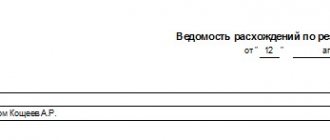How does it arise (according to the Labor Code of the Russian Federation)
- if the employee did not pass a medical examination or a knowledge test on occupational safety through no fault of his own (Article 76);
- if an employee is required to undergo a knowledge test on occupational safety during underground work, but such a test did not take place due to the fault of the employer (Article 330.4);
- if the credit institution’s license has been revoked (Article 349.4);
- if the strikers prevented a person not participating in the strike from performing his duties (Article 414).
In addition, there are many more options that the Labor Code is not able to provide for: a financial crisis, replacement of equipment or interruptions in the supply of components. And all these circumstances are characterized as simple - payment in this case is made in accordance with the Labor Code.
How to register
The difficulty lies in the fact that the Labor Code does not answer the question of how to register downtime due to the fault of the employer. But still, in order to avoid future problems and accusations from regulatory authorities of insufficient care about respecting the rights of working citizens, it is recommended to prepare an Order on the introduction of downtime.
This order should indicate:
1. Deadline.
Suspend work for the period from __.__.____ to __.__.____.
2. Reasons.
Due to a breakdown of packaging equipment...
3. List of departments affected by the order.
Suspend work for the period from __.__.____ to __.__.____ in structural divisions: procurement department; packaging department; logistics Department…
4. The names of employees who are recognized as idle due to the fault of the employer.
5. Payment procedure.
6. Instructions to employees about where they should be during the period specified in the order.
...must be at their workplaces
or
... are exempt from the obligation to report to work places
Read more about drawing up an order in the article “How to draw up an order for downtime.”
If, for example, a breakdown of equipment occurred during its operation (it does not matter whether the employee is at fault or not), the worker is obliged to report the incident to the manager so that he can draw up a report of the breakdown. This document will become the basis for issuing the order described above.
By the way, do not forget to enter the relevant information into your time sheet.
Why could this happen?
There are several reasons that can cause downtime:
Technological or technical reason
Most often, it is caused by the introduction of new equipment into production, which will require additional training and advanced training from personnel. Sometimes, suspension may occur due to
due to the failure of critical components and mechanisms, or other equipment, which will entail the inability of personnel to perform their duties until the functionality of the equipment is restored in full.
Important
For technological factors of suspension of activities, responsibility lies entirely with the employer, and during the period of such a situation, monetary compensation is paid in accordance with the procedure established by law.
Organizational
Occurs at the moment when management makes a decision to change the organization of the production process.
Economic
A common reason for downtime is the financial distress of the enterprise. Very often, there is no direct fault of the employer in this type of suspension of production. Financial crises and sharp fluctuations in demand for a particular product may be the cause of this situation. Downtime of an enterprise may be caused by non-compliance by counterparties with their obligations.
Even if the forced suspension of the company’s activities is caused by external factors, responsibility, in any case, lies with the head of the enterprise. The concept of entrepreneurial activity implies conducting business at your own peril and risk, therefore, compensation to workers must be provided in full in case of this type of suspension of the enterprise.
How do they pay?
To make the calculation, you will need Article 157 of the Labor Code: with its help, we will calculate the amount of payment using an example.
So, by law, an employee is required to receive 2/3 of his average salary for those days that he was in forced inactivity. Before we look at a specific calculation example, let's remember what the average salary is.
In short: the average salary includes not only the salary or tariff rate, but also other payments, for example, bonuses, allowances, etc. (regulatory framework - Decree of the Government of the Russian Federation dated December 24, 2007 No. 922).
For calculations, a period of 12 months is taken. All payments for this period are summed up. In addition, you need to calculate how many days the employee worked over the last year (the Production Calendar will help here).
Calculation example
The downtime lasted from June 5 to June 9, 2020 (5 working days).
Over the previous 12 months, the employee earned:
50,000 (monthly salary) x 12 months + 100,000 (one-time bonus based on the results of 2020) + 10,000 (monthly bonus for mentoring) x 12 months = 820,000 rubles.
From June 1, 2020 to May 31, 2020, the employee worked 248 days.
The average daily earnings will be 820,000 / 248 = 3306.45 rubles.
The payment amount is calculated as follows:
3306.45 rub. x 5 x 2/3 = 11,021.5 rub.
Payment for downtime due to reasons beyond our control
The formula for paying for downtime depends on the type of tariff rate.
- With a monthly tariff rate:
Payment for downtime due to independent reasons = Salary / For the number of working days in the month of downtime x 2/3 x Number of working days during downtime
- At daily tariff rate:
Payment for downtime due to independent reasons = Daily rate x 2/3 x Number of working days during downtime
- At an hourly rate:
Payment for downtime due to independent reasons = Hourly rate x 2/3 x Standard working hours per day x Number of working days during downtime
For reference
We figured out how to pay for downtime due to the employer’s fault, but remember: if the employee is at fault, he will not receive any compensation.
If the reason for the suspension of work was, for example, a natural disaster or some other event that the employer and employee could not prevent, the administration will also pay the employee 2/3, but not the average salary, but only the tariff or salary, calculated in proportion to downtime.
But there is a way to save the employee’s earnings: to do this, he is transferred to another job with the same employer for a period of no more than a month. Written consent will only be required if the transfer involves a demotion. In case of such a transfer caused by downtime as a result of emergency circumstances, the salary is paid not lower than the average earnings at the main place of work (see Article 72.2 of the Labor Code of the Russian Federation).
And don’t forget to report downtime to the Employment Center!
General rules for paying for downtime
A break (downtime) in work can happen for the following reasons:
- due to the fault of the organization;
- for reasons beyond the control of the organization and employee;
- due to the employee's fault.
Break time for reasons beyond the control of the employer and employee is paid in the amount of at least 2/3 of the tariff rate or salary, calculated in proportion to the downtime.
Downtime caused by the employee is not paid at all.
Downtime caused by the employer is paid based on average earnings. In this case, at least 2/3 of the average earnings accrued during forced rest are paid. To do this, the beginning and end of the downtime must be recorded. The manager must issue an order on the duration of the downtime and its payment.
If the downtime is prolonged, there is no need to recalculate the amount of average earnings every month.
Important
Payments to employees should be made within the deadlines established by the organization for issuing wages.
Billing period
As a general rule, the calculation is based on the employee’s average earnings over the last 12 calendar months. Let’s say the downtime began in April 2020. This means that the billing period is from April 1, 2019 to March 31, 2020.
Billing period less than a year
A different billing period can be set when:.
The employee has not yet worked for the company for 12 months. In this situation, the billing period will be the period during which the person is registered in the organization. For example, an employee joined the company on July 8, 2020. From February 2 to February 4, 2020, I went on a business trip. The billing period is from July 8, 2020 to January 31, 2020.
The employee got a job and went on a business trip in the same month. Then the calculation period is the actual time worked. Let’s assume that an employee joined the organization on January 12, 2020 and left on a business trip on January 20. The billing period will begin on January 12 and end on January 19.
It is more convenient for an organization to set its own billing period other than 12 months. In such a situation, the average earnings will have to be calculated twice (for 12 months and for the established billing period) and compared the results. In any case, average earnings cannot be less than the amount calculated on the basis of annual earnings.
There has been a reorganization and the employee is transferred to a new company. The employee can be fired from the old organization and immediately hired into a new one, or simply transferred by drawing up an additional agreement to the employment contract. When a person quits, only those payments that were accrued to him in the newly created organization are taken into account. If the employee is transferred, payments for the last 12 months are taken into account, including those accrued before the reorganization.
What is not included in the calculation period
Average earnings in the billing period do not include the time, as well as the amounts accrued during this time, when the employee:
- received temporary disability benefits or maternity benefits;
- had the right to average earnings in accordance with Russian law, among other things, on vacation or a business trip (the only exception: the employee is entitled to average earnings during breaks to feed the child, but these intervals are not excluded from the calculation period);
- did not work due to downtime due to the fault of the employer or for reasons beyond the control of management or staff;
- was unable to work due to a strike in which he did not take part;
- received additional paid days off to care for disabled children and people with disabilities since childhood;
- was released from work for other reasons in accordance with Russian legislation.
Annual leave. Let's assume that downtime has been declared since January 14, 2019. The billing period is 2020. But from July 15 to July 28, 2020 inclusive, this person was on vacation, and accordingly, his average earnings were retained. This time is excluded from the billing period.
This is also important to know:
What is the punishment for violating employee rights?
Business trip. When calculating average earnings, you must ignore the time of past business trips that occurred during the billing period. Naturally, the average earnings accrued for these periods are not needed. And it doesn’t matter that during a business trip, unlike on vacation or illness, a person fulfills his job duties.
Simple. Also excluded from the calculation is the time of previous downtime due to the fault of the employer.
Leave at your own expense and for child care. All time off without pay is also not taken into account. Similarly, days of parental leave are not taken into account. As well as the amount of child benefits, if at that time they were due to the employee.
Part-time time. It is important to take this into account when an employee first worked part-time and was then hired as a full-time employee. If a part-time worker is transferred to the main job without dismissal, then the average earnings must be calculated for 12 months, not excluding the time when he worked part-time. Therefore, the payment amount will be less than if he did not work as an external part-time worker. Is it possible to arrange it so that a person does not lose money? Yes, and there are two ways to proceed.
The first method: a person can quit his part-time job, and then re-enter the same organization, but as a full-time employee. Then the calculation period will be only the time worked as a permanent employee. The second method: stipulate in a collective agreement or other local act that in such cases the period starting from enrollment in the staff is considered the calculation period. Part six allows you to do this
Part-time work. If a person works part-time, his average earnings are calculated in the usual manner. But, of course, they take the amounts actually paid, taking into account the actual time worked.
Examples of calculating downtime and absenteeism
Average earnings during downtime are calculated as follows:
Important
Average earnings = amount of accruals for the billing period: number of days (hours) worked * number of working days (hours) to be paid
Example. CJSC Stella temporarily suspended operations from January 1, 2020 until the end of January for economic reasons. Let's calculate the average earnings during downtime using the example of one of the employees, provided that the organization has a five-day work week.
The billing period is 2020, with a total of 249 working days. The employee’s salary from January 1, 2020 was 20,000 rubles, and from October 1, 2017 it was reduced to 18,000 rubles. In addition, throughout 2017, the employee received a long service bonus in the amount of 10 percent of salary. We present in the table information about the periods excluded from the calculation:
| Base | Period | Length of period in calendar days | Accrued for time worked |
| Temporary disability | From 9 to 13 February 2020 | 5 days | RUB 14,736.84 (salary), 1473.68 rub. (surcharge) |
| Annual leave | From August 3 to August 30, 2020 | 28 days | RUB 952.38 (salary), 95.24 rub. (surcharge) |
| Vacation at your own expense | From 7 to 16 September 2020 | 10 days | RUB 10,909.09 (salary), 1090.91 rub. (surcharge) |
Thus, the time worked in the billing period accounts for 216 days (249 – 5 – 20 – 8). In January 2020 there are 15 working days. Let's calculate the amount of payment for downtime (the company pays it based on 2/3 of average earnings). First, let's calculate the total earnings for 2020:
20,000 rub. X 6 months + 14,736.84 rub. + 952.38 rub. + 10,909.09 rub. + 18,000 rub. X 3 months + 2000 rub. ? 6 months + 1473.68 rub. + 95.24 rub. + 1090.91 rub. + 1800 rub. X 3 months = 220,658.14 rub.
Now let’s determine the amount for downtime:
RUB 220,658.14 : 216 days X 15 days X 0.6667 = 10,215.65 rubles.








